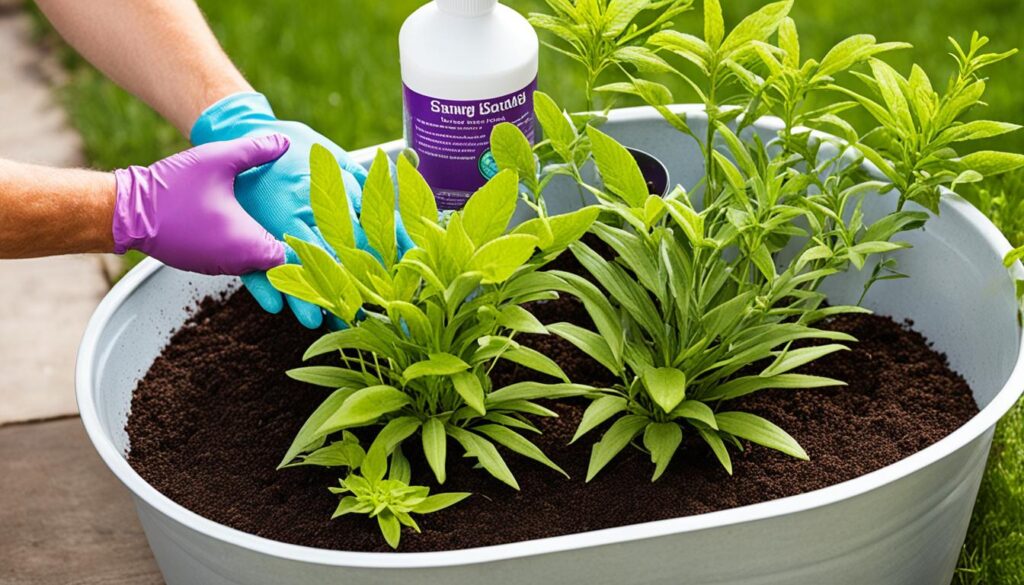
Combat Mold in Plant Soil: Effective Solutions
Is your plant soil suffering from mold? Don’t worry, we’ve got you covered. In this section, we will explore effective solutions to combat mold in plant soil. Whether you are dealing with moldy plant soil, looking for methods to remove mold from potted plants, or seeking preventive measures to stop mold growth in plant containers, we have the answers you need.
Learning how to fix mold in plant soil is crucial for the health and well-being of your plants. Mold can impede their growth and lead to various issues. By understanding plant soil mold removal techniques and moldy plant soil treatment methods, you can ensure that your plants thrive and flourish.
Moreover, mold prevention in plant soil is equally important. Taking proactive steps to prevent mold growth in plant containers will save you from future headaches and safeguard the longevity of your plants. From proper watering techniques to suitable plant placement, we will guide you through effective strategies for plant soil mold control.
Key Takeaways:
- Combat mold in plant soil with effective solutions.
- Learn how to fix mold in plant soil and remove mold from potted plants.
- Implement preventive measures to control mold growth in plant containers.
- Moldy plant soil treatment is essential for the health and vitality of your indoor plants.
- Follow our tips and techniques to ensure a healthy environment for your plants.
Tips for Removing Mold from Plant Soil
If you’ve noticed moldy soil in your plants, it’s essential to take immediate action to prevent further damage. Dealing with moldy soil in plants requires a targeted approach to ensure the health and vitality of your indoor plants. In this section, we will provide expert tips for removing mold from plant soil and carrying out effective mold treatment for indoor plants.
Identifying Mold in Plant Soil
Before you begin the removal process, it’s important to confirm the presence of mold in your plant soil. Look for signs such as a white or greenish fuzzy growth on the soil’s surface or a musty odor coming from the pot. By identifying the mold, you can implement the appropriate treatment methods for effective mold removal.
Tip: If you suspect mold but are unsure, consult with a local horticulturist or plant specialist for a proper diagnosis.
Removing Mold from Plant Soil
Here are some effective techniques to remove mold from your plant soil:
- 1. Quarantine the affected plant: Isolate the plant from others to prevent the mold from spreading.
- 2. Remove the top layer of soil: Carefully scoop out the top inch of soil containing the mold growth and discard it.
- 3. Increase air circulation: Place a small fan near the plant to improve air movement and discourage mold growth.
- 4. Adjust watering practices: Overwatering can contribute to mold growth, so be mindful of the moisture levels in the soil and adjust your watering schedule accordingly.
- 5. Apply a fungicide: Use a plant-friendly fungicide to treat the remaining soil and prevent future mold growth. Follow the manufacturer’s instructions for application.
Preventing Mold in Plant Soil
Prevention is key to maintaining mold-free plant soil:
- 1. Use well-draining soil: Ensure that your potting mix has good drainage to prevent water from becoming trapped in the soil.
- 2. Allow the soil to dry between waterings: Avoid overwatering by allowing the soil to dry out slightly before watering again.
- 3. Avoid overcrowding plants: Give your plants enough space for proper air circulation, reducing the risk of mold growth.
- 4. Monitor humidity levels: Use a hygrometer to measure humidity levels in your indoor space and take steps to maintain optimal levels for your plants.
Remember, prevention is always better than treatment when it comes to mold in plant soil. By following these tips and maintaining a healthy environment for your indoor plants, you can minimize the risk of mold growth and ensure your plants thrive.

Expert Insight: Avoid Overwatering
“Overwatering is a common cause of mold growth in plant soil. Remember, most indoor plants prefer to dry out between waterings. By adjusting your watering practices and allowing the soil to dry slightly, you can create an environment that is less favorable for mold.”
Prevention and Control of Mold in Plant Soil
To maintain healthy and thriving plants, it is essential to focus on the prevention and control of mold in plant soil. By implementing effective strategies for plant soil mold control, you can create an environment that minimizes the risk of mold growth in plant containers.
One key technique for preventing mold in plant soil is to ensure proper drainage. Good drainage allows excess water to flow out of the container, preventing waterlogged soil that can promote mold growth. Use containers with drainage holes and avoid overwatering your plants.
Another important step in preventing mold is to provide adequate airflow to the soil. Stagnant air can create a favorable environment for mold spores to settle and grow. Consider using a small fan to promote air circulation around your plants or placing them in areas with good ventilation.
In addition to drainage and airflow, it is crucial to use quality potting mix and avoid reusing soil from previous plantings. Contaminated soil can harbor mold spores and introduce them to new plants. Opt for a well-draining potting mix that is specifically formulated for indoor plants.




